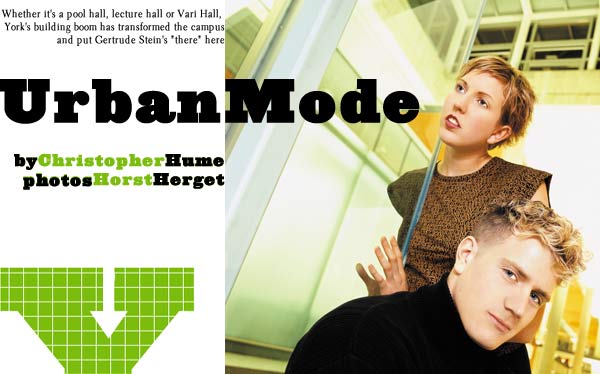 | |
Urban Mode
Story by Christopher Hume
Page: 2
| |
 |
|

ORK UNIVERSITY is changing so quickly even recent graduates would have difficulty recognizing the campus. For those, like me, who remember a wind-swept wasteland up in the middle of nowhere, it is a place transformed, and much for the better.
While York remains a campus in transition, it has become a community in the fullest sense of the word. As Gertrude Stein might have said, there's now a there there.Wandering the campus of the 21st century, one is instantly struck by the sheer amount of new construction. Everywhere you turn, a gap has been filled, a new building has appeared, and an amenity has been added.
The most dramatic changes are those that can be seen immediately on entering the campus from Keele St. The addition of Vari Hall, the Student Centre, York Lanes (York's commercial centre of restaurants and shops) and the Goldfarb Centre for Film and Theatre in the '90s irrevocably altered the image, the face, of the University. The placement of Vari Hall, directly in front of the concrete bulk of the Ross Building, says everything about an institution looking to remake itself from top to bottom.
Designed by respected Toronto architect Raymond Moriyama, the large circular hall is the physical and symbolic heart of York. Appropriately, when it opened in 1991 a small group of students showed up to protest tuition fees. With its stone and yellow-brick façade, ceremonial spaces and generous scale, Vari Hall was the first building at York to express the ideals of the University through architecture.
By contrast, York Lanes and the Student Centre represent another side of campus life. It's where students eat, drink, shop and amuse themselves when they're not in class. These enormously popular additions to campus life may serve a less "exalted" purpose, but they are no less crucial to the community.
What's more interesting about these buildings, however, what keeps them from being mere castles of consumerism is the extent to which they are integrated into the larger campus. For example, both York Lanes and the Student Centre are joined to Vari Hall by a colonnade that is open in summer, closed in winter. For much of the school year, this enclosed walkway teems with teachers and students rushing from place to place. But its glazed outer walls also help to define the (now landscaped) area beyond and connect the buildings to it.
| |
Text Menu
[ Home | Past Issues | Subscriptions | Feedback | Site Map | Search ]